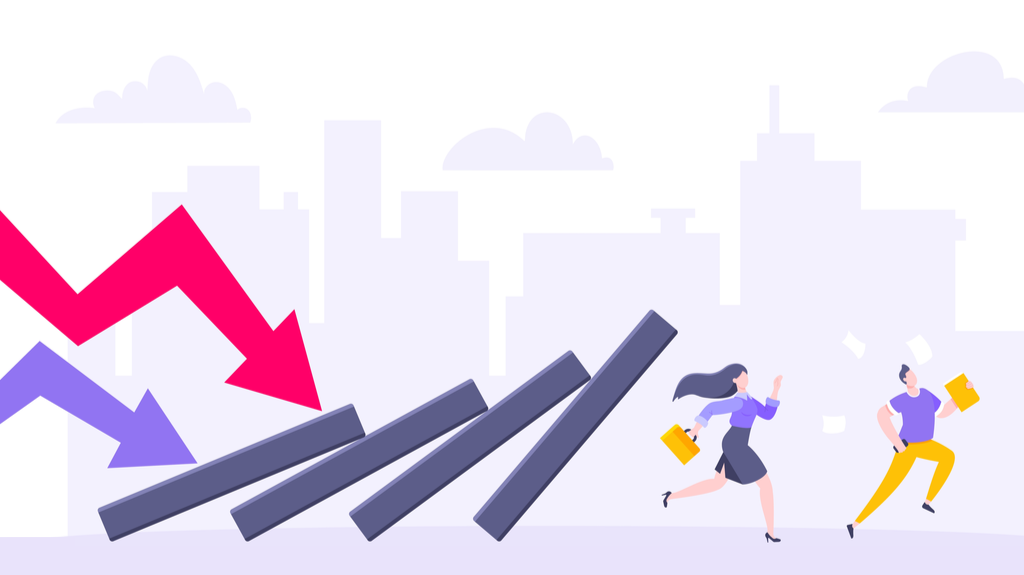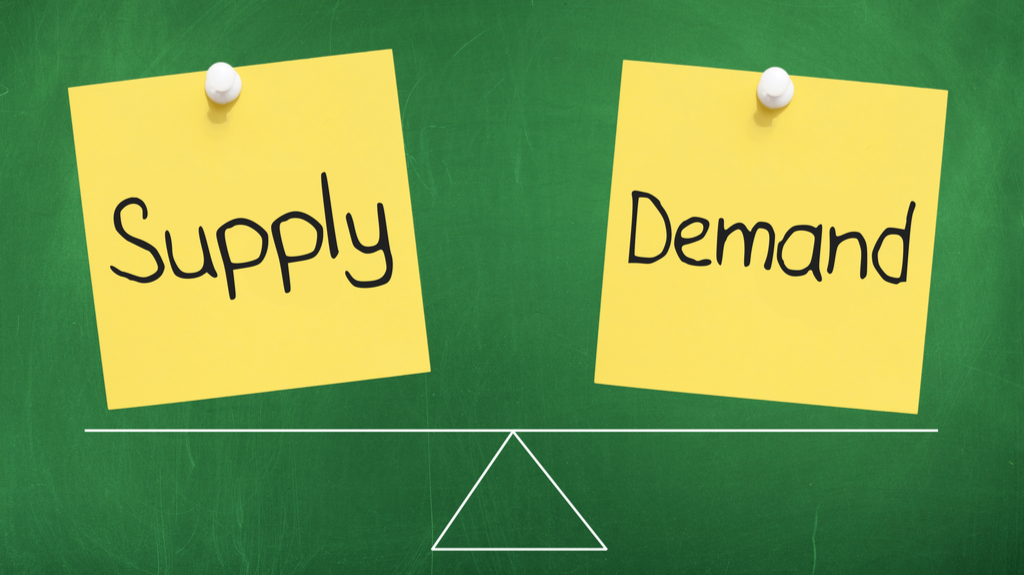Summary
COVID-19 direct and ancillary events have made clear that uncertainty is an inherent part of the demand-supply network structure. Every firm on a regular basis faces “risk situations” such as manufacturing excursion, unexpected new demand or loss of demand, component supplier interruption, etc. This has placed risk management and rapid intelligent response (RIR) front and center in the SCM news. RIR requires a thoughtful combination of data science and computational models to facilitate community intelligence and anticipate structural vulnerability points. The SCB webinar “How Data Science and Modeling Can Supercharge Your Risk Management” covers this topic in detail. This blog discusses some key challenges for data science and modeling for a firm to achieve RIR.
Introduction
At the end of the 19th century “classical physics” and its assumption of a clockwork universe was unchallenged. After a 150-year battle to replace an earth-centric (Ptolemy) modeling method to predict /explain movements of celestial objects with a sun-centric model it rapidly moved to institutionalize gravity, mechanics, and electromagnetism. At this time, the strongest objection to Darwin’s theory of evolution came from physics and its estimate of the age of the earth. By 1905 Einstein’s four papers established modern physics and identified serious limits of classical physics. The Copenhagen work on quantum mechanics made clear uncertainty was inherent in the universe. Classical physics still has an important role, but it was not sufficient for computers or GPS.
The same situation is occurring today in managing demand-supply networks (DSN). In the early 1990s when supply chain management (SCM) / S&OP started, it was viewed as a fad with no long-term prospects in the day-to-day running of an organization. As with the early sun-centric models, its performance was worse than the current incumbent (earth-centric). Performance is measured by the quality of the solution, the value of the solution, and computational feasibility. The earliest SCM offerings by SAP simply mimicked old (earth-centric) practices. In this situation, it was a challenge to do an end-to-end replan in 21-days. From 1995 to 2015, the current best practices in SCM (classical or “big bang”) took hold where the two anchor stores are demand management and central planning engines (CPE). This approach assumes a clock-work universe: single point estimate of demand, using old and ineffective approaches for intermittent demand estimation and inventory management, linear consumption of capacity, assumption of availability of component products, etc.
COVID-19 direct and ancillary events have made clear that uncertainty is inherent in the demand-supply network (DSN) universe. Other evidence of uncertainty ranges from large disruptions like chip shortages, the 2014 closure of the LA port, hurricane Maria in 2017, 2021 closure of colonial pipeline,) as well as the numerous day-to-day adjustments planners must handle with limited “cognitive tools” that fail to harness community intelligence.
It is clear the classical SCM approach must evolve too “rapid intelligent response” (RIR) to handle uncertainty. This topic is discussed in detail in the Supply Chain Brief webinar
How Data Science and Modeling Can Supercharge Your Risk Management. In this blog, I will present examples of challenges to data science and modeling to enhance the function in demand management (DM) and central planning engines (CPE).
Challenges for Data Science in Estimating Demand.
The core of best practices for classical demand management involves capturing key historical data, maintaining prior forecasts, enabling collaboration, and even better time-series forecasts – where better is defined as reducing forecast error based on fit and predict. Most software providers (including Arkieva) are focused on “forecast reducing error”.
As physicists discovered, uncertainty is built into the fabric, the challenge is to shift to bounding the uncertainty (risk profile) and insight. This is illustrated in the following umbrellas demand estimation challenge.
Figure 1 has a graph of 3 years of umbrella sales, where the classical need would be a point estimate for each month in year 4.
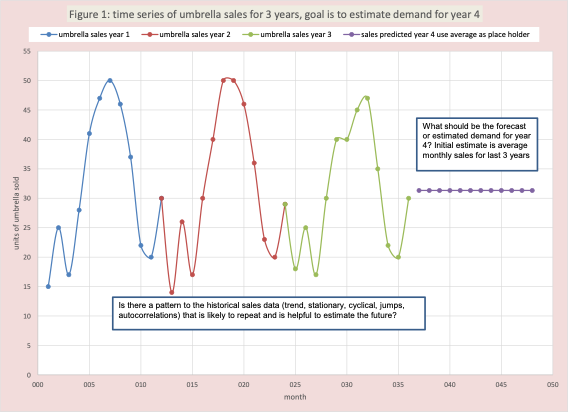
Occasionally classical demand estimation will look at simple “causal” factors. Figure 2 has umbrella sales graphed with rain fail and advertising.
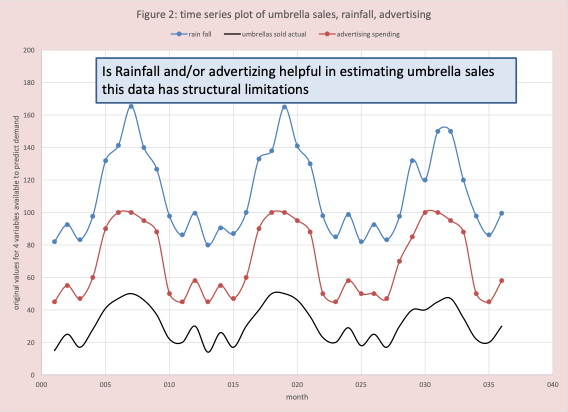
Modern SCM requires the following
- Identifying the largest uncertainty is in months 6 and 7 (Figure 3).
- Rainfall and advertising dollars are highly correlated which limits their “causal” value. (Figure 4)
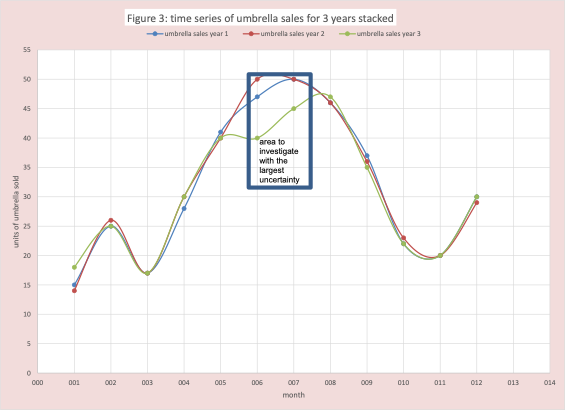
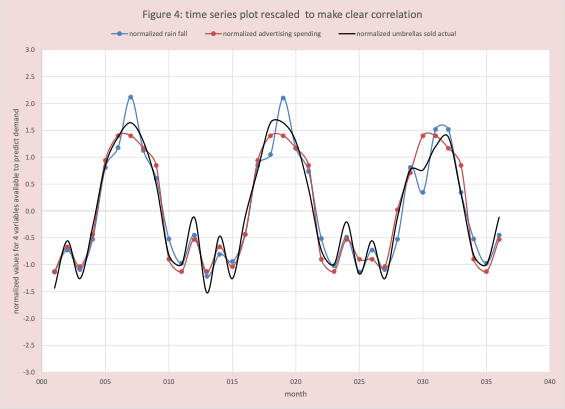
Challenges for Modeling in Central Planning Engines
- Modeling methods to support central planning engines have made substantial engineering improvements since 1995 in terms of the ability to quickly generate solutions that capture much of the complexity and size of supply planning or matching assets with demand. There are two critical enhancements that must be improved. The core of the CPE model structures is based on linear relationships including material balance that date back to 1957. There is a need to incorporate more complex structures.
- An ability to reason about the demand-supply network (Figure 5 has simple bakery DSN). For example, if the batter mixer tools have downtime, what is the impact, and how best to respond? What are potential supply vulnerabilities?
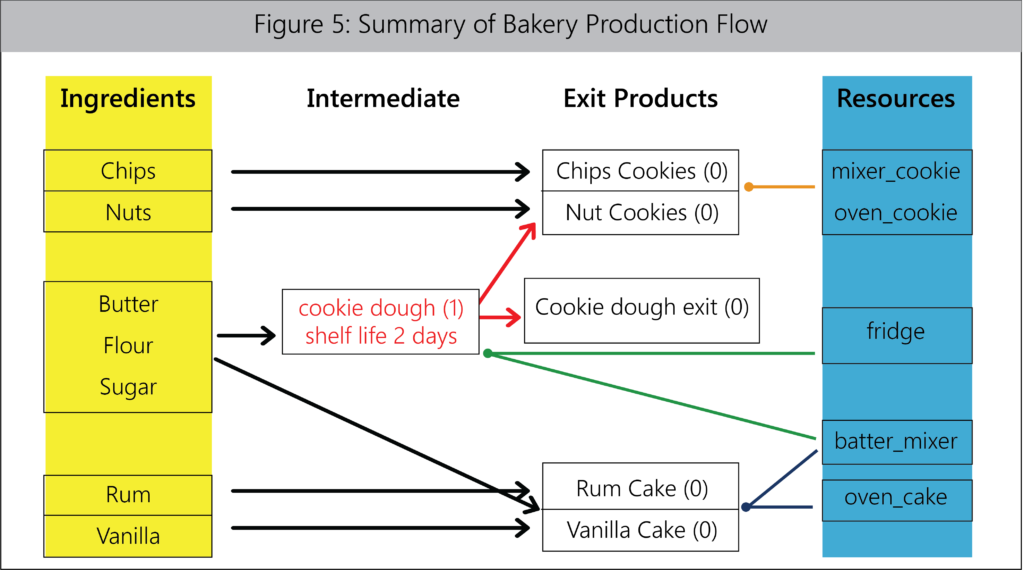
Conclusion
Successful risk management requires a thoughtful combination of data science and computational models to facilitate community intelligence and anticipate structural vulnerability points.
Enjoyed this post? Subscribe or follow Arkieva on Linkedin, Twitter, and Facebook for blog updates.



